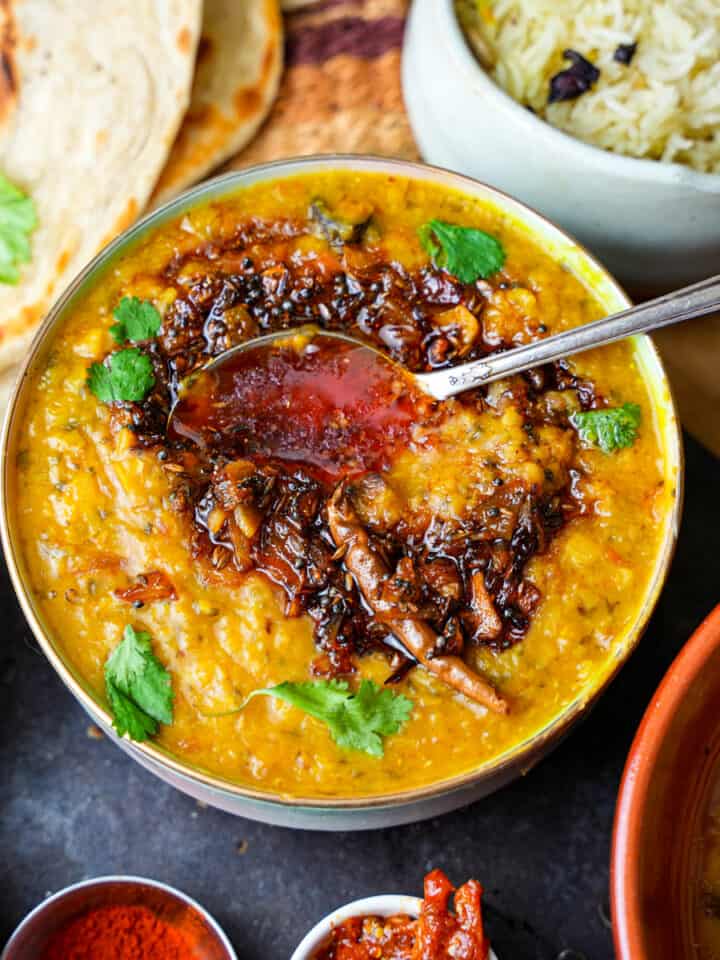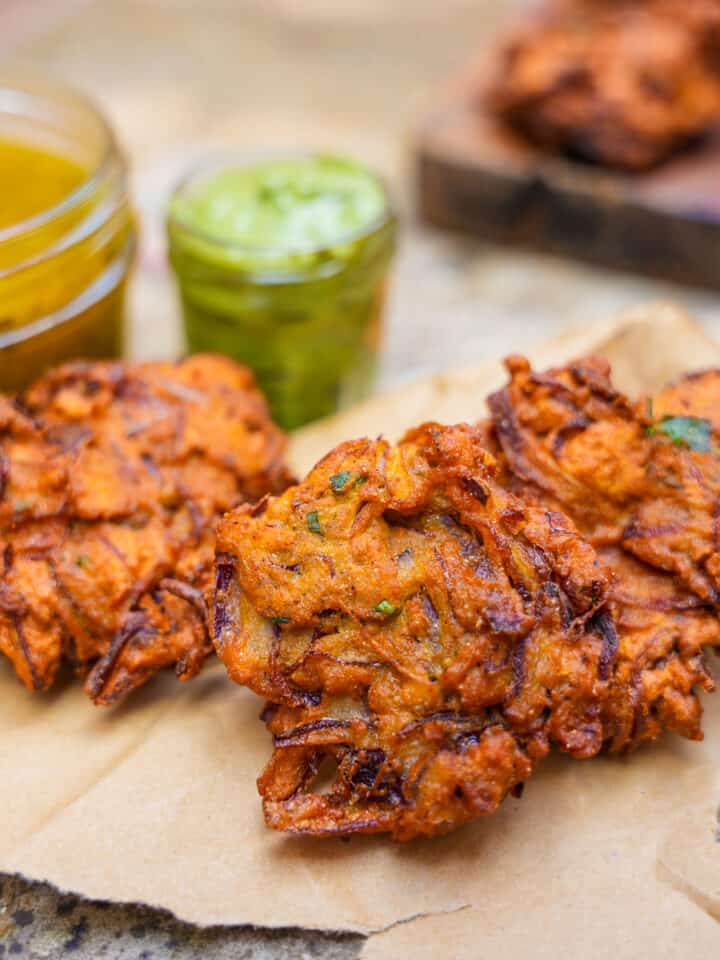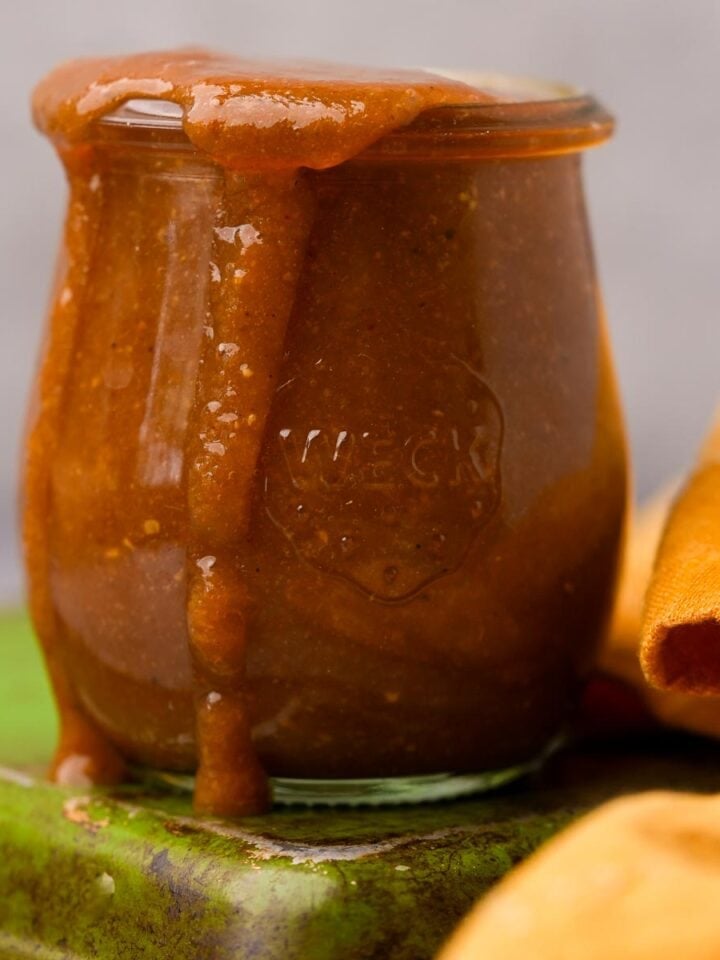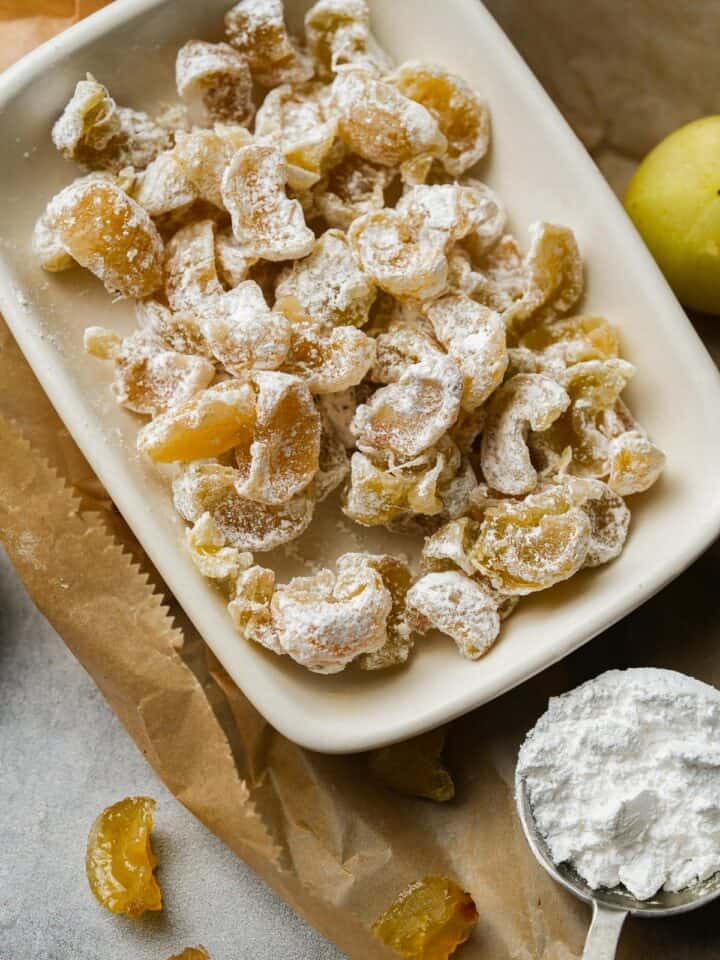*This post may contain affiliate links. Read more »
In the heart of most Indian produce markets, your senses become drawn to the sizzle, aroma, and fiery heat of sweet potatoes cooking on hot embers. Shakarkandi ki chaat is sometimes served with starfruit slices, and is adorned with sev (fried chickpea flour noodles), chaat masala, and occasionally pomegranate seeds.


Enter your email & I'll send it to your inbox. Plus, get great new recipes from me every week!
By submitting this form, you consent to receive emails from Cinnamon Snail.
Sweet potatoes can be boring, but not here. Not now. This is the peak of sweet potato flavor, and yet, it's so simple that most novice cooks will not struggle to make it at home. With each bite, the flavors will explode on your tongue, taking you on a journey through India's rich culinary heritage. The smoky sweetness of the charred sweet potatoes dance with the tanginess of fresh lime juice and amchur (dried mango powder), while the heat of green chilies mingles with the cooling touch of cilantro leaves.
This chaat goes great with other vegan Indian street food classics like my aloo papri chaat, aviyal and saag aloo.
So, grab some sweet potatoes, and let’s make some nourishing Shakarkandi ki Chaat, a dish that gives boring ol' sweet potatoes a whole new lease on life!
Jump to:
🥰Why you'll adore this shakarkandi recipe
✊Vegan AF & GF: Like all of my vegan Indian recipes, this one is made without harming animals, is gluten-free too!
🚀 Easy, Healthy, and Quick: This recipe skips the traditional hawker method of cooking sweet potatoes over embers, making it accessible for home cooks. Steaming or boiling simplifies the process, cooks them faster, and keeps them juicy and nutrient-packed.
🍲 Sattvic: Without onions or garlic, this is one of my sattvic recipes that's perfect as an offering of bhoga. If you make it without sev, it can even be suitable as an ekadasi recipe.
✅ Tested and Approved: Like all of my vegan recipes, I had this shakarkandi recipe tested by a dedicated global team of hundreds of home cooks who replicated it successfully across the world.


🤘Learn to make flawless prasadam
This guide to my most popular sattvic vegan recipes is 100% FREE, & you'll love the actual heck out of it 🥰
🍠 Ingredients for shakarkandi chaat

Sweet Potato
If you can get it, use white sweet potato known as Safed Shakarkandi in Hindi. Since it may not be available in your area, you can make this dish with regular orange-fleshed sweet potatoes or garnet yams.
Chaat Masala
This flavorful tangy, salty spice blend is great on fruits and simple chaat preparations. I like the MDH brand of Chunky Chaat Masala. If you can’t get it, you can substitute it with a mixture of ground cumin, coriander, amchur (dried mango powder), and a pinch of black salt to achieve a similar tangy and savory taste.
Fine Sev
Sev, also called Ompudi in Kannada and Nylon Sev in Gujarati, is a crispy fried noodle snack that adds a delightful crunch to dishes. If unavailable, use crushed papdi. If you are gluten-free or are observing Ekadasi Vrate, use crushed potato chips as a substitute.
Kala Namak
Kala Namak, also known as black salt, enhances the flavor of dishes with its distinctive sulfurous aroma. It can be substituted with regular table salt, but keep in mind that the unique taste of kala namak will not be replicated by basic boring ol’ salt.
Kashmiri Chili Powder
This vibrant red chili powder, originally from Kashmir, adds mild heat and rich color to dishes from mango pickle to kala chana. It can be substituted with a combination of paprika and cayenne pepper to achieve a similar effect, with a slightly less intense color.
*See the recipe card at the bottom of the page for exact quantities, nutritional info, and detailed cooking directions.
🔪The easiest way to remove seeds from a pomegranate.
With a sharp knife, score the pomegranate skin vertically from the crown down to the base, making four equally spaced incisions. The cuts should be just deep enough to penetrate the skin, but not deep enough to cut into the seeds.

- Hold the pomegranate firmly with both hands, and gently pull the fruit apart along the scored lines. It should split into several sections, revealing the vibrant red seeds inside.
- Fill a large bowl with water. Submerge the pomegranate sections in the water, one at a time, and use your fingers to gently separate the seeds from the white pith. The seeds will sink to the bottom of the bowl while the pith will float on the surface.
- Once you have separated the seeds from all the pomegranate sections, carefully skim off the floating pith from the surface of the water using the slotted spoon. Discard the pith.
- Now, using the slotted spoon, scoop out the pomegranate seeds from the bowl of water, allowing any excess water to drain through the slots. Transfer the seeds to a separate bowl.
- Now use these seeds in your fave recipes that call for pomegranate seeds like aloo papri chaat, mutabal, and this sweet potato chaat, right here!
📖How to make shakarkandi chaat
Follow along with this photo guide for making this nourishing chaat, or check out the easy-to-print recipe card towards the bottom of this page.

Step 1
Begin by peeling and cutting two medium sweet potatoes into bite-sized pieces. Aim for approximately three cups of diced sweet potatoes once they're cut. To prevent the sweet potatoes from becoming mushy, steam or boil them until they are just tender. Be mindful not to overcook them, since they will cook a little further in the next steps. You can also use roasted sweet potatoes if you prefer baking instead of boiling.

Step 2
Drain the par-cooked sweet potatoes in a wire mesh strainer or colander.

Step 3
Take a pan and heat oil over medium heat. After 60 seconds, when the oil is heated, add the cooked sweet potato pieces to the pan. Sauté them for a few minutes until they are lightly golden.

Step 4
Sprinkle the chaat masala, red chili powder, and kala namak (black salt) over the sautéed sweet potatoes. Give the potatoes a gentle toss to ensure an even coating of the spices.

Step 5
Let them cook for an additional 1-2 minutes, allowing the spices to become toasted, creating a burst of aromatic goodness on the outside of the sweet potatoes.

Step 6
Transfer the seasoned sweet potatoes to a serving dish and garnish with pomegranate seeds, freshly chopped cilantro, sev, perhaps some cilantro chutney and tamarind sauce, and a generous squeeze of fresh lemon juice from the lemon wedges.
🍽️Serving Ideas
This sweet potato chaat recipe finds great companionship with an array of dishes. It pairs wonderfully with Kanda Bhaji or Ulundu Vadai, a crispy South Indian lentil fritter, as the sweet and tangy chaat complements the savory and crunchy vadai, resulting in a delightful contrast of textures. Additionally, the chaat harmonizes beautifully with Peerkangai Kootu, a South Indian dish made with ridge gourd and lentils, as the sweet potato chaat balances the earthy and comforting notes of the kootu. Another BANGIN’ subji item you could serve with this is creamy, dreamy Udupi-style Aviyal.
For a protein-rich combination, Shakarkandi ki Chaat goes well with chana dal, or Toor Dal with a tadka of roasted cumin seeds, over veg. Biryani, fragrant aged basmati, or coconut rice. If you're craving something meaty, but follow a vegan or vegetarian diet, my seitan-based Vegan Butter Chicken is going to blow yer' gosh-darned mind. Look, if you are cooking up a whole meal with rice, dals, subjis, and chaats, you for sure are going to want to serve them with some classic flat breads. Kerala Parotta, or Msemen, are going to be the perfect delivery system for the process of curry-to-face!

🤷♀️Recipe FAQs
Allow the chaat to cool down to room temperature before storing it.
Transfer the chaat to an airtight container. Stop any garnishes such as pomegranate seeds, chopped cilantro, and sev separately, as these are best added just before serving.
Seal the container tightly and place it in the refrigerator. The chaat can be stored for up to 2-3 days.
🔥Reheating and serving the stored chaat:
Take out the desired portion of the chaat from the refrigerator.
Gently reheat the chaat in a pan on low to medium heat. Add a tiny dash of oil or water to help the sweet potatoes reheat evenly. Avoid overheating, as it can make the sweet potatoes mushy.
Once the sweet potatoes are warm, add the garnishes such as pomegranate seeds, chopped cilantro, and fine sev. This will ensure that the sev remains crisp, and the pomegranate seeds and cilantro retain their freshness.
While it is not a magic food for weight loss, Shakarkandi can be part of a well-balanced and calorie-controlled eating plan. Here's why this sweet potato dish can be beneficial:
Rich in Vitamins and Minerals: Shakarkandi is packed with essential nutrients like vitamin A, vitamin C, and potassium. These nutrients support overall health and well-being, which can contribute to maintaining a healthy weight.
Cholesterol free: because it is not made using any animal derived ingredients shakarkandi does not contain cholesterol. It doesn’t include much fat either, since the primary cooking is done either by boiling, steaming, or cooking over coals.
Low in Calories: Shakarkandi is relatively lower in calories than other starchy foods like regular potatoes. This means you can enjoy a satisfying portion without consuming excessive calories.
High in Fiber: Shakarkandi is a good source of dietary fiber, which aids in digestion, promotes satiety, and helps regulate blood sugar levels. Including fiber-rich foods like Shakarkandi can help you feel fuller for longer, reducing overeating.
The dish Shakarkandi ki Chaat is pronounced as sha-kar-kahn-dee kee chaht in English.
The name Shakarkandi originates from the Hindi language, where Shakar means sugar and Kandi refers to the tuberous root vegetable. It is commonly known as sweet potato in English.
Chaat is a term used for a category of savory street food snacks in Indian cuisine. The term Chaat comes from the Hindi word meaning to lick, as these snacks are so tasty that one can't resist licking their fingers while enjoying them.
Therefore, Shakarkandi ki Chaat literally translates to sweet potato street food snack and represents the delicious combination of sweet potatoes with flavorful chaat elements.
Yes, Shakarkandi (sweet potato) is generally considered beneficial during pregnancy. Here are some reasons why it is often recommended as a food for pregnant women:
Rich in Vitamins and Minerals: Shakarkandi is a good source of essential vitamins and minerals, including vitamin A, vitamin C, and potassium. These nutrients are important for the overall growth and development of the baby, as well as supporting the mother's health.
High in Fiber: Sweet potatoes are high in dietary fiber, which aids in digestion, helps prevent constipation, and promotes a healthy digestive system. This can be particularly beneficial during pregnancy when hormonal changes can lead to digestive issues.
Natural Source of Energy: Shakarkandi contains complex carbohydrates that provide sustained energy, essential during pregnancy when energy needs are increased. It can help combat fatigue and keep you feeling energized throughout the day.
Antioxidant Properties: Sweet potatoes are rich in antioxidants, including beta-carotene, which can help strengthen the immune system and protect against oxidative stress.
✌️My faves to serve with shakarkandi:

Shakarkandi ki chaat (Indian sweet potato street food)
Equipment
Ingredients
- 2 medium sweet potatoes
- 4 teaspoons sunflower oil canola oil, or vegetable oil
- 2 teaspoons chaat masala
- ½ teaspoon Kashmiri red chili powder
- ½ teaspoon kala namak black salt
To garnish:
- ⅓ cup pomegranate seeds
- 2 tablespoons cilantro chopped
- lemon wedges
- 4 teaspoons fine sev
Instructions
- Peel and cut two medium sweet potatoes into bite-sized pieces. It should be about three cups of diced sweet potatoes once cut. Steam or boil the sweet potato pieces until they are just tender, but not overcooked and mushy. Once cooked, set them aside.
- Heat sunflower, canola, or vegetable oil in a pan over medium heat. Add the cooked sweet potato pieces to the pan and sauté them for a few minutes until they develop a slight crispiness on the edges.
- Sprinkle the chaat masala, red chili powder, and kala namak over the sautéed sweet potatoes. Gently toss the potatoes to ensure they are evenly coated with the spices. Cook for an additional 1-2 minutes to allow the spices to become toasted all over the outsides of the sweet potato.
- Transfer the seasoned sweet potatoes to a serving dish. Garnish them with pomegranate seeds, chopped cilantro, and fresh lemon juice from the lemon wedges.
- Finally, sprinkle fine sev (crispy fried noodles) on top of the chaat to add a contrasting salty crunch.
Notes
- If you are following Ekadasi Vrata, or fasting for Caturmasya, use crushed potato chips instead of the sev.
- It is crucial not to overcook the sweet potatoes when initially steaming or boiling. That way, they will not fall apart on you when sautéing them with the spices.

Enter your email & I'll send it to your inbox. Plus, get great new recipes from me every week!
By submitting this form, you consent to receive emails from Cinnamon Snail.











Meg says
This is great! I air fried the potato and dumped the spices on and left it to marinate… will be doing this again! Lovely side dish for the Chana masala and dal.
Thank you Chef Adam
Adam Sobel says
Meg- there's a couple other ridge gourd recipes on the blog you might dig if you loved this. Check out the beerakaya sabji if you haven't made it yet.
Shirley Salvatore says
Easy to make and full of flavor. The different textures of the sweet potato, sev, and pomegranate are a treat. Definitely a keeper.